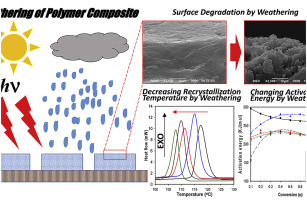Our official English website, www.x-mol.net, welcomes your
feedback! (Note: you will need to create a separate account there.)
Environmental aging and degradation of multiwall carbon nanotube reinforced polypropylene
Carbon ( IF 10.5 ) Pub Date : 2018-04-01 , DOI: 10.1016/j.carbon.2017.10.038 Changseok Han 1 , Endalkachew Sahle-Demessie 2 , Amy Q Zhao 2 , Teri Richardson 2 , Jun Wang 3
Carbon ( IF 10.5 ) Pub Date : 2018-04-01 , DOI: 10.1016/j.carbon.2017.10.038 Changseok Han 1 , Endalkachew Sahle-Demessie 2 , Amy Q Zhao 2 , Teri Richardson 2 , Jun Wang 3
Affiliation

|
The degradation of polypropylene (PP) and PP-multiwalled carbon nanotube (PP-MWCNT) panels during environmental weathering resulted in an increased degree of crystallinity, making them brittle, and creating surface cracks. The degradation led to a breakdown of the panels and increased the potential for nanorelease. Thermal analysis revealed that the thickness of the test panels and reinforcement with MWCNTs had a significant influence on the stability of PP-MWCNT composites. Differential scanning calorimetry indicated that the MWCNTs acted as nucleation points, increasing the crystallization temperatures of PP-MWCNT, which reduced the extent of aging. Weathering decreased both the melting and crystallization temperatures of PP by as much as 20 o C. The reduction in the temperatures was inversely proportional to the thickness of the panels. The activation energy (E a ) obtained using isoconversional kinetics of the TGA analysis showed that the effective thermo-oxidative degradations of PP changed during aging. The E a for the initial stages of thermal degradation decreased from ~330 kJ/mol to ~100 kJ/mol for aged PP. During the late degradation stages, the E a values increased to ~300 kJ/mol. These results suggest that early degradation were altered because of the changes in the molecular structure of the aged P and a shift in the degradation rate-limiting steps.
中文翻译:

多壁碳纳米管增强聚丙烯的环境老化与降解
聚丙烯 (PP) 和聚丙烯多壁碳纳米管 (PP-MWCNT) 面板在环境风化过程中的降解导致结晶度增加,使其变脆并产生表面裂纹。降解导致面板损坏并增加了纳米释放的可能性。热分析表明,测试板的厚度和多壁碳纳米管增强对 PP-多壁碳纳米管复合材料的稳定性有显着影响。差示扫描量热法表明,多壁碳纳米管作为成核点,提高了聚丙烯多壁碳纳米管的结晶温度,从而降低了老化程度。风化使 PP 的熔化和结晶温度降低了 20 o C。温度的降低与面板的厚度成反比。使用 TGA 分析的等转化动力学获得的活化能 (E a ) 表明,PP 的有效热氧化降解在老化过程中发生了变化。对于老化的PP,热降解初始阶段的E a 从~330 kJ/mol 降低到~100 kJ/mol。在降解后期,E a 值增加到~300 kJ/mol。这些结果表明,由于老化 P 分子结构的变化和降解速率限制步骤的变化,早期降解发生了变化。E a 值增加到~300 kJ/mol。这些结果表明,由于老化 P 分子结构的变化和降解速率限制步骤的变化,早期降解发生了变化。E a 值增加到~300 kJ/mol。这些结果表明,由于老化 P 分子结构的变化和降解速率限制步骤的变化,早期降解发生了变化。
更新日期:2018-04-01
中文翻译:

多壁碳纳米管增强聚丙烯的环境老化与降解
聚丙烯 (PP) 和聚丙烯多壁碳纳米管 (PP-MWCNT) 面板在环境风化过程中的降解导致结晶度增加,使其变脆并产生表面裂纹。降解导致面板损坏并增加了纳米释放的可能性。热分析表明,测试板的厚度和多壁碳纳米管增强对 PP-多壁碳纳米管复合材料的稳定性有显着影响。差示扫描量热法表明,多壁碳纳米管作为成核点,提高了聚丙烯多壁碳纳米管的结晶温度,从而降低了老化程度。风化使 PP 的熔化和结晶温度降低了 20 o C。温度的降低与面板的厚度成反比。使用 TGA 分析的等转化动力学获得的活化能 (E a ) 表明,PP 的有效热氧化降解在老化过程中发生了变化。对于老化的PP,热降解初始阶段的E a 从~330 kJ/mol 降低到~100 kJ/mol。在降解后期,E a 值增加到~300 kJ/mol。这些结果表明,由于老化 P 分子结构的变化和降解速率限制步骤的变化,早期降解发生了变化。E a 值增加到~300 kJ/mol。这些结果表明,由于老化 P 分子结构的变化和降解速率限制步骤的变化,早期降解发生了变化。E a 值增加到~300 kJ/mol。这些结果表明,由于老化 P 分子结构的变化和降解速率限制步骤的变化,早期降解发生了变化。











































 京公网安备 11010802027423号
京公网安备 11010802027423号